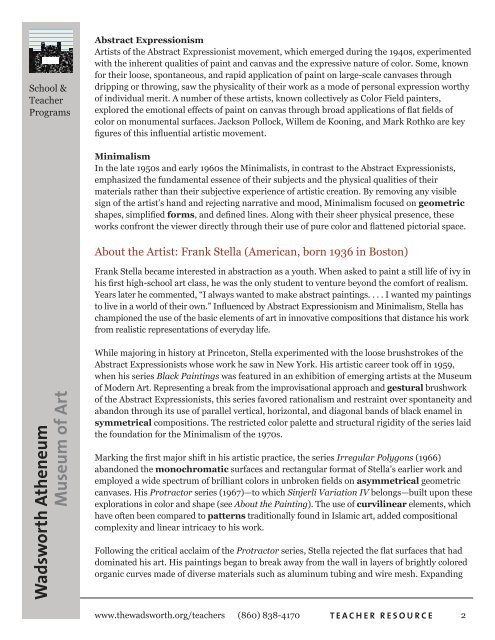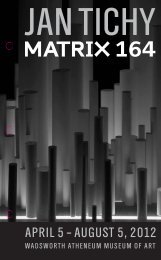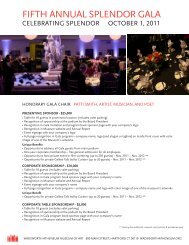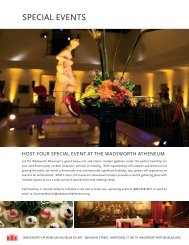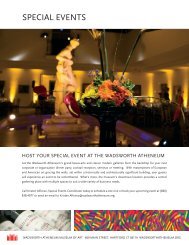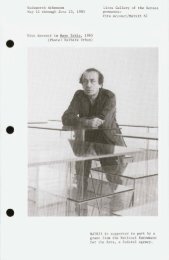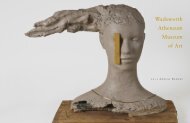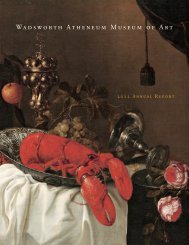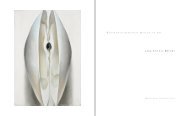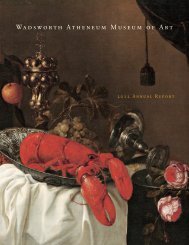Frank Stella - The Wadsworth Atheneum
Frank Stella - The Wadsworth Atheneum
Frank Stella - The Wadsworth Atheneum
Create successful ePaper yourself
Turn your PDF publications into a flip-book with our unique Google optimized e-Paper software.
School &<br />
Teacher<br />
Programs<br />
<strong>Wadsworth</strong> <strong>Atheneum</strong><br />
Museum of Art<br />
Abstract Expressionism<br />
Artists of the Abstract Expressionist movement, which emerged during the 1940s, experimented<br />
with the inherent qualities of paint and canvas and the expressive nature of color. Some, known<br />
for their loose, spontaneous, and rapid application of paint on large-scale canvases through<br />
dripping or throwing, saw the physicality of their work as a mode of personal expression worthy<br />
of individual merit. A number of these artists, known collectively as Color Field painters,<br />
explored the emotional effects of paint on canvas through broad applications of flat fields of<br />
color on monumental surfaces. Jackson Pollock, Willem de Kooning, and Mark Rothko are key<br />
figures of this influential artistic movement.<br />
Minimalism<br />
In the late 1950s and early 1960s the Minimalists, in contrast to the Abstract Expressionists,<br />
emphasized the fundamental essence of their subjects and the physical qualities of their<br />
materials rather than their subjective experience of artistic creation. By removing any visible<br />
sign of the artist’s hand and rejecting narrative and mood, Minimalism focused on geometric<br />
shapes, simplified forms, and defined lines. Along with their sheer physical presence, these<br />
works confront the viewer directly through their use of pure color and flattened pictorial space.<br />
About the Artist: <strong>Frank</strong> <strong>Stella</strong> (American, born 1936 in Boston)<br />
<strong>Frank</strong> <strong>Stella</strong> became interested in abstraction as a youth. When asked to paint a still life of ivy in<br />
his first high-school art class, he was the only student to venture beyond the comfort of realism.<br />
Years later he commented, “I always wanted to make abstract paintings. . . . I wanted my paintings<br />
to live in a world of their own.” Influenced by Abstract Expressionism and Minimalism, <strong>Stella</strong> has<br />
championed the use of the basic elements of art in innovative compositions that distance his work<br />
from realistic representations of everyday life.<br />
While majoring in history at Princeton, <strong>Stella</strong> experimented with the loose brushstrokes of the<br />
Abstract Expressionists whose work he saw in New York. His artistic career took off in 1959,<br />
when his series Black Paintings was featured in an exhibition of emerging artists at the Museum<br />
of Modern Art. Representing a break from the improvisational approach and gestural brushwork<br />
of the Abstract Expressionists, this series favored rationalism and restraint over spontaneity and<br />
abandon through its use of parallel vertical, horizontal, and diagonal bands of black enamel in<br />
symmetrical compositions. <strong>The</strong> restricted color palette and structural rigidity of the series laid<br />
the foundation for the Minimalism of the 1970s.<br />
Marking the first major shift in his artistic practice, the series Irregular Polygons (1966)<br />
abandoned the monochromatic surfaces and rectangular format of <strong>Stella</strong>’s earlier work and<br />
employed a wide spectrum of brilliant colors in unbroken fields on asymmetrical geometric<br />
canvases. His Protractor series (1967)—to which Sinjerli Variation IV belongs—built upon these<br />
explorations in color and shape (see About the Painting). <strong>The</strong> use of curvilinear elements, which<br />
have often been compared to patterns traditionally found in Islamic art, added compositional<br />
complexity and linear intricacy to his work.<br />
Following the critical acclaim of the Protractor series, <strong>Stella</strong> rejected the flat surfaces that had<br />
dominated his art. His paintings began to break away from the wall in layers of brightly colored<br />
organic curves made of diverse materials such as aluminum tubing and wire mesh. Expanding<br />
www.thewadsworth.org/teachers (860) 838-4170 T E A C H E R R E S O U R C E<br />
2


